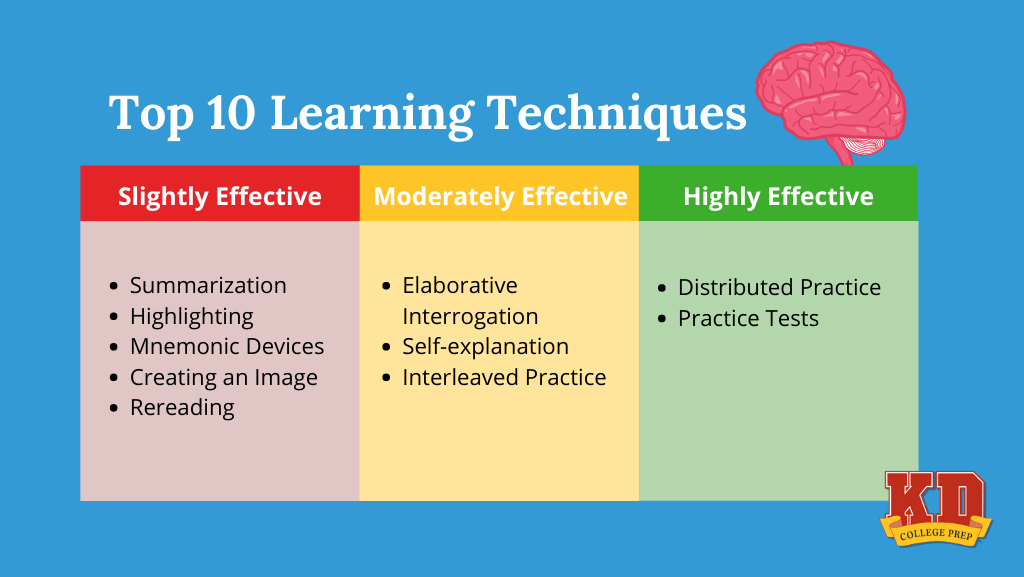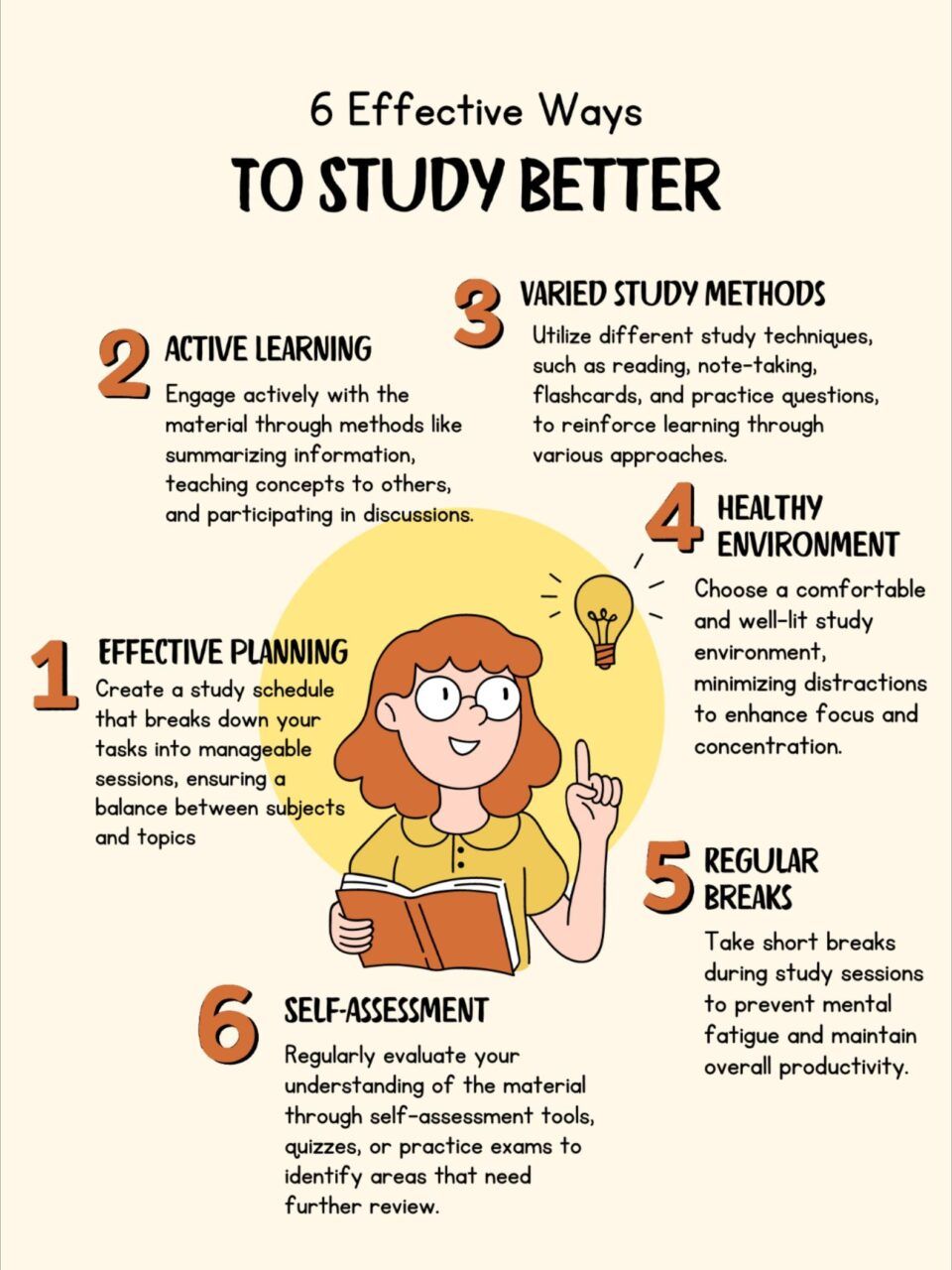Effective Study Techniques to Boost Your Learning and Academic Success
Study techniques are essential for any student striving to succeed academically. The right study methods not only help you understand and retain information more effectively but also allow you to study smarter, not harder. Whether you’re preparing for exams or working through coursework, the way you approach studying can make a significant difference in your performance.
In this guide, we’ll explore effective study techniques that will enhance your learning experience and improve your results.

Why Study Techniques Matter
Understanding the importance of study techniques is the first step toward academic success. Without proper methods, even the most diligent student may struggle to absorb and recall information efficiently. Effective techniques help you break down complex material, stay focused, and retain knowledge for longer periods.
Adopting the right techniques allows you to maximize your study time and reduce unnecessary stress, enabling you to perform better without sacrificing your well-being.
1. Active Recall: The Power of Retrieval
Active recall is one of the most powerful study techniques you can use. Instead of simply reviewing notes or textbooks, active recall involves testing yourself on the material.
How Active Recall Works
You can practice active recall by reading a section of your textbook, then closing it and trying to recall the key concepts from memory. Writing down what you remember helps reinforce your learning. This process strengthens neural connections and helps you remember the information more effectively.
Why It’s Effective
Active recall forces you to retrieve information, which strengthens your memory and enhances your long-term retention. Research shows that testing yourself regularly is far more effective than passive review techniques, such as re-reading your notes.

2. Spaced Repetition: Reinforcing Knowledge Over Time
Another powerful technique is spaced repetition, which involves reviewing material at increasing intervals. Instead of cramming the night before an exam, spaced repetition helps you review information in small, manageable chunks over a longer period.
How Spaced Repetition Works
Using flashcards or a spaced repetition app like Anki can help you schedule reviews of previously studied material. For example, you might review a concept a day after learning it, then a week later, then a month later. This helps you retain the information more effectively.
Why It’s Effective
Spaced repetition takes advantage of the spacing effect, which shows that information is retained better when reviewed periodically over time. It’s especially useful for subjects requiring memorization, such as languages, history, or medical studies.
3. The Pomodoro Technique: Maximizing Focus and Productivity
If staying focused for long study sessions is a challenge, the Pomodoro Technique can be a game-changer. This time management method involves working in focused intervals, followed by short breaks.
How It Works
In the Pomodoro Technique, you study for 25 minutes, then take a 5-minute break. After completing four intervals, you take a longer break of 15 to 30 minutes. This method helps maintain high levels of concentration while preventing mental fatigue.
Why It’s Effective
The Pomodoro Technique leverages the brain’s natural focus cycle. Short bursts of work allow you to stay productive without becoming overwhelmed. It also encourages regular breaks, which help refresh your mind and keep you motivated.
4. Mind Mapping: Organizing Ideas Visually
Mind mapping is a creative and visual technique that helps you organize your thoughts and connect concepts. It’s especially useful for subjects that require you to understand complex relationships between ideas, such as science, history, or literature.
How Mind Mapping Works
Start by writing the main concept in the center of the page, then branch out with related subtopics and details. Use lines, colors, and shapes to visually organize and connect ideas. You can use tools like MindMeister or traditional pen and paper to create your maps.
Why It’s Effective
Mind mapping taps into both the visual and associative parts of the brain, making it easier to understand and remember complex information. It encourages active engagement with the material, which boosts comprehension and retention.
5. Teach What You Learn: Reinforcing Knowledge by Teaching
One of the best ways to consolidate your learning is by teaching what you’ve learned to someone else. This technique involves explaining concepts aloud, as if you were teaching them to another person.
How Teaching Reinforces Learning
When you teach someone else, you force yourself to articulate your understanding in a clear, structured way. This not only helps reinforce the material but also highlights any gaps in your knowledge that need to be filled.
Why It’s Effective
Teaching others forces you to simplify complex ideas, deepening your understanding. It’s a great way to review material and ensure that you truly grasp the concepts.
6. Use Active Note-Taking Methods
Active note-taking involves more than just transcribing lectures or reading material. Instead, focus on organizing the information in a way that makes it easier to understand and review.
How Active Note-Taking Works
One popular method is the Cornell Note-Taking System, which divides your notes into three sections: cues, notes, and summary. After the lecture or reading, write down key points and review them later to reinforce your learning.
Why It’s Effective
Active note-taking helps you process the information as you write, which enhances comprehension and retention. It also makes it easier to review your notes later, as you’ve organized the material in a meaningful way.
7. Practice Problem-Solving
For subjects like mathematics, engineering, or computer science, problem-solving is an essential study technique. The more problems you solve, the better you’ll understand the material and develop your skills.
How Problem-Solving Works
Start by reviewing example problems and understanding the steps taken to solve them. Then, attempt similar problems on your own. Don’t hesitate to check the solutions, but try to solve as many problems as possible independently.
Why It’s Effective
Problem-solving reinforces the theoretical concepts you’ve learned and helps you apply them in practical scenarios. It’s an active approach that solidifies your understanding through hands-on practice.
8. The Feynman Technique: Simplify and Explain
The Feynman Technique is a study method named after physicist Richard Feynman. It involves simplifying complex topics and explaining them as if you were teaching a child. This method forces you to break down information into simple, digestible parts.
How It Works
To apply the Feynman Technique, choose a topic, then explain it in simple terms without using jargon. If you encounter something you can’t explain, revisit the material until you can explain it clearly.
Why It’s Effective
The Feynman Technique reveals any gaps in your understanding and helps you master the material by simplifying it. By explaining things clearly, you gain a deeper understanding of the concepts.

FAQs on Study Techniques
1. Which study technique is best for memorizing information?
For memorization, techniques like spaced repetition and active recall are most effective. Flashcards, whether physical or digital, can help you retain facts over time by reviewing them at spaced intervals.
2. How can I stay motivated while studying?
Staying motivated can be challenging, but setting clear goals, using reward systems, and breaking tasks into smaller chunks can help maintain focus and momentum. Consider trying the Pomodoro Technique to keep your study sessions short and productive.
3. How often should I take breaks while studying?
It’s essential to take regular breaks to prevent burnout. The Pomodoro Technique suggests taking a 5-minute break every 25 minutes of focused study, with a longer break every few sessions.
4. What is the best way to study for exams?
To study effectively for exams, use a combination of active recall, spaced repetition, and practice problems. Create a study plan well in advance and review material periodically instead of cramming the night before.
Conclusion
Mastering effective study techniques is key to academic success. By incorporating active recall, spaced repetition, and techniques like mind mapping and problem-solving into your study routine, you can improve your learning efficiency and retention. Consistency is key—stick with these techniques, adjust as needed, and watch your academic performance soar.
Remember, studying smarter, not harder, is the ultimate goal. With the right methods, you’ll not only improve your grades but also feel more confident in your learning journey.








